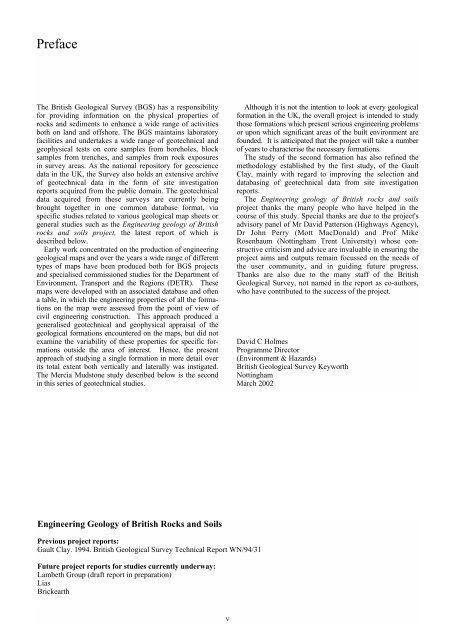Engineering geology of British rocks and soils Mudstones of the ...
Engineering geology of British rocks and soils Mudstones of the ...
Engineering geology of British rocks and soils Mudstones of the ...
You also want an ePaper? Increase the reach of your titles
YUMPU automatically turns print PDFs into web optimized ePapers that Google loves.
Preface<br />
The <strong>British</strong> Geological Survey (BGS) has a responsibility<br />
for providing information on <strong>the</strong> physical properties <strong>of</strong><br />
<strong>rocks</strong> <strong>and</strong> sediments to enhance a wide range <strong>of</strong> activities<br />
both on l<strong>and</strong> <strong>and</strong> <strong>of</strong>fshore. The BGS maintains laboratory<br />
facilities <strong>and</strong> undertakes a wide range <strong>of</strong> geotechnical <strong>and</strong><br />
geophysical tests on core samples from boreholes, block<br />
samples from trenches, <strong>and</strong> samples from rock exposures<br />
in survey areas. As <strong>the</strong> national repository for geoscience<br />
data in <strong>the</strong> UK, <strong>the</strong> Survey also holds an extensive archive<br />
<strong>of</strong> geotechnical data in <strong>the</strong> form <strong>of</strong> site investigation<br />
reports acquired from <strong>the</strong> public domain. The geotechnical<br />
data acquired from <strong>the</strong>se surveys are currently being<br />
brought toge<strong>the</strong>r in one common database format, via<br />
specific studies related to various geological map sheets or<br />
general studies such as <strong>the</strong> <strong>Engineering</strong> <strong>geology</strong> <strong>of</strong> <strong>British</strong><br />
<strong>rocks</strong> <strong>and</strong> <strong>soils</strong> project, <strong>the</strong> latest report <strong>of</strong> which is<br />
described below.<br />
Early work concentrated on <strong>the</strong> production <strong>of</strong> engineering<br />
geological maps <strong>and</strong> over <strong>the</strong> years a wide range <strong>of</strong> different<br />
types <strong>of</strong> maps have been produced both for BGS projects<br />
<strong>and</strong> specialised commissioned studies for <strong>the</strong> Department <strong>of</strong><br />
Environment, Transport <strong>and</strong> <strong>the</strong> Regions (DETR). These<br />
maps were developed with an associated database <strong>and</strong> <strong>of</strong>ten<br />
a table, in which <strong>the</strong> engineering properties <strong>of</strong> all <strong>the</strong> formations<br />
on <strong>the</strong> map were assessed from <strong>the</strong> point <strong>of</strong> view <strong>of</strong><br />
civil engineering construction. This approach produced a<br />
generalised geotechnical <strong>and</strong> geophysical appraisal <strong>of</strong> <strong>the</strong><br />
geological formations encountered on <strong>the</strong> maps, but did not<br />
examine <strong>the</strong> variability <strong>of</strong> <strong>the</strong>se properties for specific formations<br />
outside <strong>the</strong> area <strong>of</strong> interest. Hence, <strong>the</strong> present<br />
approach <strong>of</strong> studying a single formation in more detail over<br />
its total extent both vertically <strong>and</strong> laterally was instigated.<br />
The Mercia Mudstone study described below is <strong>the</strong> second<br />
in this series <strong>of</strong> geotechnical studies.<br />
<strong>Engineering</strong> Geology <strong>of</strong> <strong>British</strong> Rocks <strong>and</strong> Soils<br />
Previous project reports:<br />
Gault Clay. 1994. <strong>British</strong> Geological Survey Technical Report WN/94/31<br />
Future project reports for studies currently underway:<br />
Lambeth Group (draft report in preparation)<br />
Lias<br />
Brickearth<br />
v<br />
Although it is not <strong>the</strong> intention to look at every geological<br />
formation in <strong>the</strong> UK, <strong>the</strong> overall project is intended to study<br />
those formations which present serious engineering problems<br />
or upon which significant areas <strong>of</strong> <strong>the</strong> built environment are<br />
founded. It is anticipated that <strong>the</strong> project will take a number<br />
<strong>of</strong> years to characterise <strong>the</strong> necessary formations.<br />
The study <strong>of</strong> <strong>the</strong> second formation has also refined <strong>the</strong><br />
methodology established by <strong>the</strong> first study, <strong>of</strong> <strong>the</strong> Gault<br />
Clay, mainly with regard to improving <strong>the</strong> selection <strong>and</strong><br />
databasing <strong>of</strong> geotechnical data from site investigation<br />
reports.<br />
The <strong>Engineering</strong> <strong>geology</strong> <strong>of</strong> <strong>British</strong> <strong>rocks</strong> <strong>and</strong> <strong>soils</strong><br />
project thanks <strong>the</strong> many people who have helped in <strong>the</strong><br />
course <strong>of</strong> this study. Special thanks are due to <strong>the</strong> project's<br />
advisory panel <strong>of</strong> Mr David Patterson (Highways Agency),<br />
Dr John Perry (Mott MacDonald) <strong>and</strong> Pr<strong>of</strong> Mike<br />
Rosenbaum (Nottingham Trent University) whose constructive<br />
criticism <strong>and</strong> advice are invaluable in ensuring <strong>the</strong><br />
project aims <strong>and</strong> outputs remain focussed on <strong>the</strong> needs <strong>of</strong><br />
<strong>the</strong> user community, <strong>and</strong> in guiding future progress.<br />
Thanks are also due to <strong>the</strong> many staff <strong>of</strong> <strong>the</strong> <strong>British</strong><br />
Geological Survey, not named in <strong>the</strong> report as co-authors,<br />
who have contributed to <strong>the</strong> success <strong>of</strong> <strong>the</strong> project.<br />
David C Holmes<br />
Programme Director<br />
(Environment & Hazards)<br />
<strong>British</strong> Geological Survey Keyworth<br />
Nottingham<br />
March 2002

















